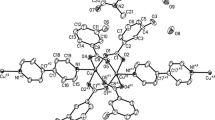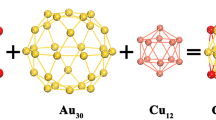Abstract
Three new MOFs with the same components but different structures and magnetic behavior, {[Cu6(atr)6(H2O)2(µ3-OH)2(SO4)5]·5.25H2O} n (1), {[Cu2(atr)2(µ-OH)2(SO4)]·3H2O} n (2), and {[Cu7(atr)6(H2O)6(µ3-OH)2(SO4)6]·2H2O} n (3) (atr = 4-amino-1,2,4-triazole), were respectively synthesized by diffusion reactions in the presence of different structure-directing agents. Complex 1 is a slightly spin-frustrated antiferromagnetic layer with sulfonate aggregated CuII 6 clusters periodically extended by ditopic sulfonate linkers. 2 is a grid-based coplanar sheet with hydroxyl group bridged -CuOCu- linear-chain interlinked by pairs of µ3-atr ligands, exhibiting strong antiferromagnetic interactions to lead to an S = 0 spin ground state at low temperature. In contrast, air-instable 3 has a ladder-like broad-ribbon structure constructed from triangular CuII 3 cores and centrosymmetric CuII 1 octahedra. Obviously, the variable CuII-ligand connectivity and the involving magnetic properties are significantly dominated by the cooperative and variable binding modes of the mixed sulfonate-atr ligands and bi-/tridentate bridging hydroxyl heterobridges.
Similar content being viewed by others
References
Kurmoo M. Magnetic metal-organic frameworks. Chem Soc Rev, 2009, 38: 1353–1379
Leuenberger MN, Loss D. Quantum computing in molecular magnets. Nature, 2001, 410: 789–793
Sessoli R, Gatteschi D, Caneschi A, Novak MA. Magnetic bistability in a metal-ion cluster. Nature, 1993, 365: 141–143
Wang XY, Wang ZM, Gao S. Constructing magnetic molecular solids by employing three-atom ligands as bridges. Chem Commun, 2008, 281–294
Zeng YF, Hu X, Liu FC, Bu XH. Azido-mediated systems showing different magnetic behaviors. Chem Soc Rev, 2009, 38: 469–480
Ouellette W, Jones S, Zubieta J. Solid state coordination chemistry of metal-1,2,4-triazolates and their related metal-4-pyridyltetrazolates. CrystEngComm, 2011, 13: 4457–4485
Yang EC, Liu ZY, Shi XJ, Liang QQ, Zhao XJ. Two 3D triazolate-tricarboxylate-bridged CuII/I frameworks by one-pot hydrothermal synthesis exhibiting spin-canted antiferromagnetism and strong antiferromagnetic couplings. Inorg Chem, 2010, 49: 7969–7975
Yang EC, Liu ZY, Wu XY, Zhao XJ. A 3D CoII framework with alternating vertex- and edge-sharing δ-ribbons showing a two-step field-induced magnetic transition. Chem Commun, 2011, 47: 8629–8631
Yang EC, Yang YL, Liu ZY, Liu KS, Wu XY, Zhao XJ. Two unique antiferromagnetic 3D frameworks with unusual CuII 4 cluster and alternate CuII 4 + CuII 1 structural motif tuned by aromatic polycarboxylate coligand. CrystEngComm, 2011, 13: 2667–2673
Zhang SM, Chang Z, Hu TL, Bu, XH. New three-dimensional porous metal organic framework with tetrazole functionalized aro matic carboxylic acid: Synthesis, structure, and gas adsorption properties. Inorg Chem, 2010, 49: 11581–11586
Tong XL, Hu TL, Zhao JP, Wang YK, Zhang H, Bu XH. Chiral magnetic metal-organic frameworks of MnII with achiral tetrazolate-based ligands by spontaneous resolution. Chem Commun, 2010, 8543–8545
Li JR, Yu Q, Sañudo EC, Tao Y, Bu XH. An azido-CuII-triazolate complex with utp-type topological network, showing spin-canted antiferromagnetism. Chem Commun, 2007, 2602–2604
Zhang XF, Yang Q, Zhao JP, Hu TL, Chang Z, Bu XH. Three interpenetrated copper(II) coordination polymers based on a V-shaped ligand: Synthesis, structures, sorption and magnetic properties. Sci China Chem, 2011, 54: 1446–1453
Zhang JP, Zhang YB, Lin JB, Chen XM. Metal azolate frameworks: From crystal engineering to functional materials. Chem Rev, 2012, 112: 1001–1033
Zhang SY, Zhang ZJ, Shi W, Zhao B, Cheng P, Liao DZ, Yan SP. Structural evolution and magnetic properties of Co(II) coordination polymers varied from 1D to 3D constructed by 1,4-bis(1,2,4-triazol-1-ylmethyl)benzene. Dalton Trans, 2011, 40: 7993–8002
Grosjean A, Daro N, Kauffmann B, Kaiba A, Letarda JF, Guionneau P. The 1-D polymeric structure of the [Fe(NH2trz)3](NO3)2·nH2O (with n = 2) spin crossover compound proven by single crystal investigations. Chem Commun, 2011, 47: 12382–12384
Dırtu MM, Neuhausen C, Naik AD, Rotaru A, Spinu L, Garcia Y. Insights into the origin of cooperative effects in the spin transition of [Fe(NH2trz)3](NO3)2: the role of supramolecular interactions evidenced in the crystal structure of [Cu(NH2trz)3](NO3)2·H2O. Inorg Chem, 2010, 49: 5723–5736
Dırtu MM, Rotaru A, Gillard D, Linares J, Codjovi E, Tinant B, Garcia Y. Prediction of the spin transition temperature in FeII one-dimensional coordination polymers: an anion based database. Inorg Chem, 2009, 48: 7838–7852
Yang EC, Liu ZY, Zhao LN, Yang YL, Zhang CH, Zhao XJ. Ligand-deprotonation induced structural diversity in a ternary CuII-triazole-tetracarboxylate self-assembly system: Synthesis, crystal structures, and magnetic behavior. CrystEngComm, 2011, 13: 5401–5408
Yang EC, Zhang CH, Liu ZY, Zhang N, Zhao LN, Zhao XJ. Three copper(II) 4-amino-1,2,4-triazole complexes containing differently deprotonated forms of 1,3,5-benzenetricarboxylic acid: Synthesis, structures and magnetism. Polyhedron, 2012, 40: 65–71
Drabent K, Ciunik Z. Counter anion dependent symmetry of CuII-4-amino-1,2,4-triazole polymeric chains. Chem Commun, 2001, 1254–1255
Chen D, Liu YJ, Lin YY, Zhang JP, Chen XM. Packing polymorphism of a two-dimensional copper(I) 3-amino-1,2,4-triazolate coordination polymer. CrystEngComm, 2011, 13: 3827–3831
Papariantafyllopoulou C, Aromi G, Tasiopoulos AJ, Nastopoulos V, Raptopoulou CP, Teat SJ, Escuer A, Perlepes SP. Use of the sulfato ligand in 3d-metal cluster chemistry: A family of hexanuclear nickel(II) complexes with 2-pyridyl-substituted oxime ligands. Eur J Inorg Chem, 2007, 2761–2774
Tamasi G, Cini R. Study of binary and ternary metal complexes containing the sulfato ligand: molecular models for selected non-catalytic sites in sulfurylase. Dalton Trans, 2003, 2928–2936
Sheldrick GM. SADABS, Siemens area detector absorption corrected software. University of Göttingen, Germany, 1996
Sheldrick GM. SAINT. Bruker AXS, Madison, WI, 1998
Sheldrick GM. SHELXL-97, Program for X-ray Crystal Structure Refinement. University of Göttingen, Germany, 1997
Sheldrick GM. SHELXS-97, Program for X-ray Crystal Structure Solution. University of Göttingen, Germany, 1997
Nakamoto K. Infrared and Raman Spectra of Inorganic and Coordination Compounds. New York: Wiley, 1986
Nakamoto K, Fujita J, Tanaka S, Kobayashi M. Infrared spectra of metallic complexes. IV. Comparison of the infrared spectra of unidentate and bidentate metallic complexes. J Am Chem Soc, 1957, 79: 4904–4908
Addison AW, Rao TN. Synthesis, structure, and spectroscopic properties of copper (II) compounds containing nitrogen-sulphur donor ligands: the crystal and molecular structure of aqua[1,7-bis(N-methylbenzimidazol-2′-yl)-2,6-dithiaheptane]copper(II) perchlorate. J Chem Soc Dalton Trans, 1984, 1349–1356
Zhai QG, Wu XY, Chen SM, Zhao ZG, Lu CZ. Construction of Ag/1,2,4-triazole/polyoxometalates hybrid family varying from diverse supramolecular assemblies to 3-D rod-packing framework. Inorg Chem, 2007, 46: 5046–5058
Borrás-Almenar JJ, Clemente-juan JM, Coronado E, Tsukerblat BS. High-nuclearity magnetic clusters: Generalized spin Hamiltonian and its use for the calculation of the energy levels, bulk magnetic properties, and inelastic neutron scattering spectra. Inorg Chem, 1999, 38: 6081–6088
Kahn O. Molecular Magnetism. Weinheim: VCH, 1993
Author information
Authors and Affiliations
Corresponding authors
Electronic supplementary material
Rights and permissions
About this article
Cite this article
Yang, E., Wang, X., Zhang, C. et al. Three new MOFs with unusual CuII 6 cluster, linear CuII chain and triangular CuII 3 core motifs tuned by sulfonate group: Synthesis, structures and magnetic properties. Sci. China Chem. 56, 465–474 (2013). https://doi.org/10.1007/s11426-012-4782-8
Received:
Accepted:
Published:
Issue Date:
DOI: https://doi.org/10.1007/s11426-012-4782-8




